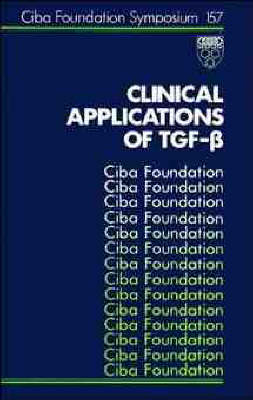
Clinical Applications of TGF-B
Symposium Proceedings
Seiten
1991
John Wiley & Sons Ltd (Verlag)
978-0-471-92811-9 (ISBN)
John Wiley & Sons Ltd (Verlag)
978-0-471-92811-9 (ISBN)
- Titel ist leider vergriffen;
keine Neuauflage - Artikel merken
Part of the "CIBA Foundation Symposium" series, this volume embodies the proceedings of a conference held in June 1990 on the clinical applications of TGF-B, and contains the latest information on the TGF-B family and its receptors. Topics covered include the effects of TGF-B in the liver.
Clinical Applications of TGF-s Chairman: M.B. Sporn 1991 TGF-s, originally identified as a transforming growth factor, is now known to exist as a family of factors with similar properties. These factors promote cell proliferation in some tissue types or conditions and induce cell differentiation in others. This book contains the latest information on the molecular biology of this family and the cognate receptors. TGF-s regulates the expression of components of the extracellular matrix, and thus cell adhesion and migration - processes that are particularly important during development and tumorigenesis. TGF-s has an effect on many cell types, which means that it, or its antagonists, may have clinical applications in diseases of many different tissues. It is already showing promise as a therapeutic agent in bone and wound healing. Increased expression of TGF-s is associated with the fibrosis that occurs in chronic liver disease (TGF-s1) and in pulmonary fibrosis of the lung (TGF-s1 and 2). Treatment with an anti-TGF-s1 antiserum attenuated the histological manifestations of disease in an experimental model of glomerulonephritis.
In the haemopoietic system, TGF-s arrests the growth of the most primitive stem cells and could therefore be used as a bone marrow protrctive agent during chemotherapy. In contrast, TGF-s2 is produced by glioblastomas and may contribute to the malignancy of these tumours by impairing tumour surveillance - another case in which treatment with an antagonist may be useful. The complex effects of TGF-s in different tissues make it a very exciting agent, but one which must be used with care. This book evaluates the behaviour of the TGF-s family in many contexts and provides a basis for future clinical application. Other Ciba Foundation Symposia: No 143 The biology of hyaluronan Chairman: T.C. Laurent 1989 ISBN 0 471 92305 2 No 148 Molecular control of haemopoiesis Chairman: D. Metcalf 1990 ISBN 0 471 92561 6 No 150 Proto-oncogenes in cell development Chairman: T. Hunter 1990 ISBN 0 471 92686 8
Clinical Applications of TGF-s Chairman: M.B. Sporn 1991 TGF-s, originally identified as a transforming growth factor, is now known to exist as a family of factors with similar properties. These factors promote cell proliferation in some tissue types or conditions and induce cell differentiation in others. This book contains the latest information on the molecular biology of this family and the cognate receptors. TGF-s regulates the expression of components of the extracellular matrix, and thus cell adhesion and migration - processes that are particularly important during development and tumorigenesis. TGF-s has an effect on many cell types, which means that it, or its antagonists, may have clinical applications in diseases of many different tissues. It is already showing promise as a therapeutic agent in bone and wound healing. Increased expression of TGF-s is associated with the fibrosis that occurs in chronic liver disease (TGF-s1) and in pulmonary fibrosis of the lung (TGF-s1 and 2). Treatment with an anti-TGF-s1 antiserum attenuated the histological manifestations of disease in an experimental model of glomerulonephritis.
In the haemopoietic system, TGF-s arrests the growth of the most primitive stem cells and could therefore be used as a bone marrow protrctive agent during chemotherapy. In contrast, TGF-s2 is produced by glioblastomas and may contribute to the malignancy of these tumours by impairing tumour surveillance - another case in which treatment with an antagonist may be useful. The complex effects of TGF-s in different tissues make it a very exciting agent, but one which must be used with care. This book evaluates the behaviour of the TGF-s family in many contexts and provides a basis for future clinical application. Other Ciba Foundation Symposia: No 143 The biology of hyaluronan Chairman: T.C. Laurent 1989 ISBN 0 471 92305 2 No 148 Molecular control of haemopoiesis Chairman: D. Metcalf 1990 ISBN 0 471 92561 6 No 150 Proto-oncogenes in cell development Chairman: T. Hunter 1990 ISBN 0 471 92686 8
Multiple forms of TGF-B - distinct promoters and differential expression, A.B.Roberts et al; TGF-B receptors, P.R.Segarini; mechanisms in TGF-B action, J.Massague et al; regulation of epithelial proliferation by TGF-B, H.L.Moses et al; effects of TGF-Bs in the liver - cell proliferation and fibrogenesis, N.Fausto et al; role of TGF-B1 in experimental glomerulonephritis, W.A.Border et al; TGF-B in pulmonary fibrosis, N.Khalil and A.H.Greenberg; in vivo and in vitro effects of TGF-B on normal and neoplastic haemopoiesis, F.W.Ruscetti et al; expression of TGF-B2 in human glioblastoma - a role in resistance to immune rejection?, A.Fontana.
| Erscheint lt. Verlag | 27.3.1991 |
|---|---|
| Reihe/Serie | Ciba Foundation Symposium ; 157 |
| Zusatzinfo | 31 figures, 18 tables |
| Verlagsort | Chichester |
| Sprache | englisch |
| Maße | 135 x 255 mm |
| Gewicht | 530 g |
| Themenwelt | Studium ► 2. Studienabschnitt (Klinik) ► Pathologie |
| Naturwissenschaften ► Biologie ► Genetik / Molekularbiologie | |
| Naturwissenschaften ► Biologie ► Zellbiologie | |
| ISBN-10 | 0-471-92811-9 / 0471928119 |
| ISBN-13 | 978-0-471-92811-9 / 9780471928119 |
| Zustand | Neuware |
| Haben Sie eine Frage zum Produkt? |
Mehr entdecken
aus dem Bereich
aus dem Bereich
Klinisch-pathologische Übersichtskarten
Buch | Hardcover (2023)
Springer (Verlag)
CHF 48,95


